Coming to Netflix on September 23. When I first heard about the project, I was intrigued. I thought it had possibilities. Now I’m not so sure:
August 2020
Mon 31 Aug 2020
TV Movie Trailers I’m Watching: ENOLA HOLMES (2020).
Posted by Steve under Movie & TV Trailers , Mystery movies[7] Comments
Mon 31 Aug 2020
Archived Mystery Review: RICHARD LOCKRIDGE – The Old Die Young.
Posted by Steve under Reviews[9] Comments
RICHARD LOCKRIDGE – The Old Die Young. Nathan Shapiro #12. Lippincott & Crowell, hardcover, 1980. No paperback edition.

In recent weeks a couple of old pros in the world of mystery fiction have shown their fans that they’re both alive and well, which is welcome news indeed. [The second book is by Ngaio Marsh, and it will come up for review in a few days.]
Each has added a creditable entry to the already sizable list of detective novels that have been produced under their names over the past forty years and more. Separately, I hasten to add, and distinctively.
Taking the male member of this pair of famous writers first – a small change of pace, and there’s nothing wrong with that, is there? – Richard Lockridge’s actual collaborator for most of his first fifty-five books was, of course, his first wife, Frances. Together, their most famous creation was the celebrated husband-and-wife sleuthing team, Mr. and Mrs. North. When Frances died in 1963, it meant the end of the Norths as a detective team, alas, but the adventures of some of their other characters have never ceased to appear. This is Richard Lockriddge’s twenty-fifth book as a solo act.
An aptly chosen word, I think. The Lockridge fictional milieu has always been that of Manhattan and the closer suburban environs, but I think that a closer look would show that very often forming the basis for the immediate story has been the Broadway theatre.
And so it is here. The mysterious death of a leading man a little too old for the part he’s playing draws Lieutenant (soon to be Captain) Nathan Shapiro into the world of bright lights and theatrical temperaments so synonymous with life along the Great White Way.
Shapiro I picture as a sad basset hound who, no matter what case he finds himself on, invariably thinks of himself as in over his head. There are no sudden flashes of brilliance that come in the solving of his cases. He does not believe in coincidence. A steady flow of evidence accumulates against the killer.
For all of its brightly crisp dialogue, always a standard Lockridge trademark, and a brief glimpse or two at modern morality, this is a mystery still very much old-fashioned in tone, with little or no action to speak of, but with a good many speaking parts.
Rating: B minus
Bibliographic Update: This was, alas, Richard Lockridge’s final book. He died in 1982.
Sun 30 Aug 2020
A Movie Review by David Vineyard: A HOUSE IS NOT A HOME (1964).
Posted by Steve under Films: Drama/Romance , Reviews[21] Comments
A HOUSE IS NOT A HOME. Embassy Pictures, 1964. Shelly Winters, Robert Taylor, Cesar Romero, Ralph Taeger, Kaye Ballard, Broderick Crawford, Mickey Shaugnessy, Jessie White, Lisa Seagram, Benny Rubin, Mari Welles, Tom deAndrea, Edy Williams, Connie Gilchrist, J. Pat O’Malley, Hayden Rorke, Roger C. Carmel. Screenplay by Russell Rouse & Charles Greene, based on the autobiography of Polly Adler. Directed by Russell Rouse.
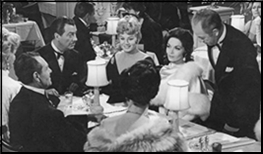
A House is Not a Home, and in this case it isn’t much of a movie either.
Supposed to be frank and shocking this is mostly tired and trite, unless you are deeply shocked by someone shouting the word “whore†on screen, or by the fact men pay for sex there is nothing much in this that wouldn’t be perfectly at home with the board of censors.
Better movies had been much racier and more frank in this same period without once having to scream the word “whore,†out loud or repeatedly (and in a tour de force of bad overacting).
Polish immigrant Polly Adler (Shelly Winters) is poor and innocent (and Winters at this point in the film is a parody of the kind of part she played so well in A Place in the Sun, actually painful to watch), narrating her fall and rise and moral fall in Adler’s own self serving “what’s a girl to do†style.
After getting in trouble with a guy she is rescued by good guy Bootlegger Frank Costigan (Robert Taylor) a mobster with ties in government and crime who aides Polly in her becoming a famous madam with rich clients and lady like prostitutes who dress well and behave, mostly.
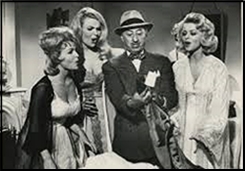
Innocent Polly just wakes up a madam one day with absolutely no clue how it happened.
Meanwhile still nice Polly meets bandleader Casey (Ralph Taeger) who she falls tragically in love with much to her later regret.
No attempt is made to use period costume or clothes, and the sets are few and far between. It might as well be 1964 in most scenes, and this television instead of a movie.
Mickey Shaughnessy is a crooked cop “Backdoor Reardon†(and no, not one person involved in the film seems to have gotten just how hilarious that is in this context); Broderick Crawford a crooked cop; Cesar Romero Lucky Luciano; Lisa Seagram a prostitute with a drug problem; Roger C. Carmel a drug addicted horn player, Hayden Rorke a crooked lawyer becoming Luciano’s private judge; Kaye Ballard young Polly’s pal in a sweat shop; J. Pat O’Malley a police inspector; and so on.
In short a blend of old familiar faces and “and then I slept with†film bio.
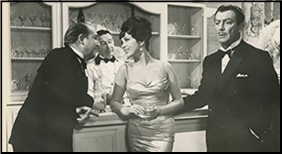
Gee, that’s profound. I think most of us figured that out around puberty, but it is nice to know the world’s most famous madam picked up on it. The Happy Hooker, Polly ain’t. By this movie, save for being raped early on, you could draw the conclusion that Polly herself is a virgin, just a poor little golden-hearted darling picked on by all the mean gangsters, politicians, and policemen wanting a cut of the pound of flesh she carves out of her girls lives.
The screenplay is a paean to Dick and Jane level dialogue, so pretentious and self serving not a single word sounds as if it had ever passed the lips of an actual living human in the real world. Polly’s ghost writer sounds as if he read The Old Curiosity Shop and Fanny Hill over and over to get the tone he wanted.
Attractive Meri Welles suicide is a highlight/lowlight a moment of overacting by an an under-talent that could end any career. The writing, staging, and Winters hysterics will have you on the floor laughing. The proper reaction is “throw another one in the river and see if they float.â€
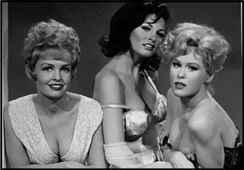
You have to show people as human before their fate means anything even in a movie this bad. Welles sudden New Year’s depression and leap from a balcony is staged like a high school production of the balcony scene from Romeo and Juliet, without context and telegraphed so broadly Marconi could read it from his grave.
Bad movies come and go, this one mostly went, except it had one thing going for it, seems a couple of young songwriters tackled the title song, and when their names were Hal David and Burt Bacharach, the result was far better than anything in the film. “And a house is not a home, unless love is there..†may not be Cole Porter, but it blows anything in this film away.
No one really gets a career boost from this. Taylor sleepwalks, Winters keeps trying to act as if this was a real movie. Romero tries hard not to be noticed. Everyone else just does their schtick, though Shaugnessy could be prosecuted for mugging in the first degree.
“You’ve been a madam, you sold flesh. They haven’t made a soap that can wash that away,†Polly is told by Frank (Robert Taylor) who actually opens his eyes to deliver this gem.
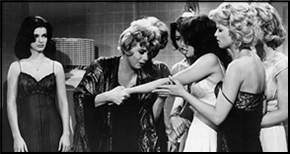
Polly tries desperately to escape her fate when Casey proposes, but Frank’s words ring too true. What is a poor girl to do, but write a bestseller and have something to retire on.
Apparently Polly read one too many Cornell Woolrich novels without having learned the point about fate so she madly dances as gangster Frank looks on trapped like a poor canary in her life of sin … “she’s only a bird in a golden cage …â€
And though she would be good again, this is the exact point Winters career became a satire, a parody of what she was at her best.
As a general rule it should be noted something about the idea of whorehouses brings out the worst in everyone involved in a Hollywood drama. They work well enough in comedy, but get serious and you can wade knee deep in the angst and overacting.
Do yourself a favor, listen to the title song over the credits and then quickly turn to something else. It is only the only defense against this film.

Sat 29 Aug 2020
PI Stories I’m Reading: BILL PRONZINI “One Night at Dolores Park.â€
Posted by Steve under Stories I'm Reading[3] Comments
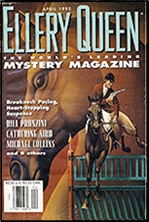
BILL PRONZINI “One Night at Dolores Park.†Short story. Nameless PI. First published in Ellery Queen’s Mystery Magazine, April 1995. Collected in Spadework (Crippen & Landru, 1996) and Dago Red: Tales of Dark Suspense (Ramble House, 2015). Reprinted in The Year’s 25 Finest Crime and Mystery Stories: Fifth Annual Edition, edited by the staff of Mystery Scene magazine (Carroll & Graf, 1996) and A Century of Noir: Thirty-two Classic Crime Stories, edited by Mickey Spillane & Max Allan Collins (Berkley, softcover, 2002).
When this story was written, the section of San Francisco dubbed Dolores Park was falling into urban decay, complete with drug dealers, burglaries and constant intimidation, with people moving out left and right. And in this short tale, that’s where Bill Pronzini’s Nameless PI has quite a night for himself. (Also noted, but only incidentally, one of the characters mistakenly calls him Orenzi.)
Nameless is there in the first place on a stakeout to serve some papers on a resident who’s a reluctant witness in case handled by the lawyer who hired him, then he himself is a witnesses to a would-be mugging of another resident, a woman who really ought to have known better.
But do muggers generally have guns? Nameless intervenes and takes the would-be victim safely home, only to find himself in the midst of a marriage that’s falling apart as decisively as the neighborhood in which the couple find themselves living. This is a powerfully done tale of parallel and contrast, and yes, of course, it’s a detective story, too.
Fri 28 Aug 2020
A PI Movie Review: ONE FOR THE MONEY (2012).
Posted by Steve under Mystery movies , Reviews[11] Comments
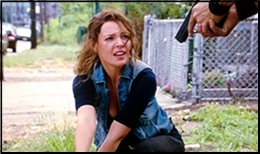
ONE FOR THE MONEY. Lionsgate, 2012. Katherine Heigl (Stephanie Plum), Jason O’Mara (Joseph Morelli), Daniel Sunjata (Ranger), John Leguizamo, Sherri Shepherd, Debbie Reynolds. Based on the book by Janet Evanovich. Director: Julie Anne Robinson. Available on DVD and currently streaming on Amazon Prime.
As everybody may already know, romance writer Janet Evanovich hit literary gold when she created New Jersey girl bounty hunter Stephanie Plum. There are now 27 in the series, the most recent being Fortune and Glory (2020), which I believe is the first without its number in the title.

Besides the criminous side of the things, there is a continuing romantic triangle with both vice cop Joe Morelli and fellow bounty hunter Ranger striving for the hand, if not more, of the extremely fetching Stephanie – just the kind of thing that keeps the ladies coming back for more, and done in such a way that menfolk don’t find much to object to, either.
In One for the Money, one of Stephanie’s first bounty hunting jobs – she is broke and needs the money – is to bring in Joe Morelli, who is accused of deliberately shooting a suspect who had no gun while doing a bust. It’s a weak story, admittedly, or perhaps a story weakly told, but I at least found the characters a whole lot of fun to watch. Not hilarious, as advertised, but fun.

The movie was an absolute bust with both the critics and the box office, which has completely eliminated the possibility of any more Stephanie Plum movies being made. Other the other hand, I am not alone in liking this film. If she is to be believed, and quoting from Wikipedia, “author Janet Evanovich was delighted with how the film turned out and did some joint interviews with Heigl to promote the film. Evanovich stated that she would now envision Heigl as Stephanie when writing the character.†I’m delighted to be in such good company.

Thu 27 Aug 2020
Archived Mystery Review: ROBERT L. FISH – The Gold of Troy.
Posted by Steve under Reviews[4] Comments
ROBERT L. FISH – The Gold of Troy. Doubleday, hardcover, 1980. Berkley, paperback, 1984.

Everyone loves a treasure hunt, and of course the bigger the prize the better. Except that what the prize consists of this time is a large chestful of cheap-looking trinkets, made of what looks like a poor grade of brass.
It’s not long, however, before we learn that this is in actuality the famous Schliemann treasure, a priceless collection of golden relics of the Trojan War, discovered by archaeologists over a hundred years ago.
The treasure was lost at the end of World War II in Nazi Germany, but it has suddenly reappeared. Someone has it, no one knows who, and it has been put up for bids in ·a mammoth worldwide auction. The CIA has always thought the Russians have had it. The KGB has been convinced that it was the Americans who stole it away during the confusion at the end of the war. Each is now sure that the other’s security has been breached.
A love affair is also involved, between two people ordinarily worlds apart. She is the newly appointed head of the Metropolitan Museum of Art; he is Russia’s leading authority on matters archaeological. Together as they hunt down this small treasure of buttons and beads, their love is consummated, nearly lost, and then wrapped up neatly again in a wild whirlwind of a finish.
The machinations of the plot obviously come from the head of the author alone. The characters have little to say in how they’re manipulated. As great lasting literature, this would never do. As to why the book is so readable, why it is gulped down so easily and quickly, there is an equally easy explanation. To put it in simplest possible terms, Fish knows how to tell a story.
Rating: B plus.
Wed 26 Aug 2020
A Sci-Fi PI TV Episode Review: HAUNTED “Pilot†(2002).
Posted by Steve under Reviews , TV mysteries , TV Science Fiction & Fantasy[10] Comments

HAUNTED “Pilot.†UPN, 60m. 24 September 2002. Matthew Fox as PI Frank Taylor, Russell Hornsby, John Mann, Lynn Collins, Michael Irby, Bree Michael Warner. Director: Michael Rymer. The complete series is available on DVD.
It’s been a couple of nights since I watched this, and to tell you the truth, it made such a little impression on me that other than Matthew Fox, the rest of the cast are only names to me. I’m going to take a very sad way out and use the Wikipedia description of the show: “Private detective Frank Taylor, whose marriage to Jessica Manning ended after their son was abducted, kills a pedophile, Simon Dunn, and almost dies himself. When he discovers he can now see the dead, he uses this ability to find a missing boy kidnapped by Simon, who now haunts him.â€
Part of the problem is that this is all claptrap to me. I watched this only because of the fact that Fox plays a private detective in this, not that that’s made very clear. The whole thing’s a muddle. Maybe it got better as time went on. Eleven episodes were aired before it disappeared for good. (A fact which is actually not so. Repeats have been shown on the Sci-Fi channel, Chiller, and Universal HD.)

PostScript: Kevin Burton Smith on his Thrilling Detective website liked the first episode better than did I, but he also goes on to say that the show would have been better if they’d played up the PI end of things, and that “the pop-up ghost gimmick was already annoying by the end of the show.â€
He also says, contrary to Wikipedia, that in the series’ first run on UPN, only seven of the eleven episodes were actually aired.

Wed 26 Aug 2020
A Mystery Review by Ray O’Leary: ANNE PERRY – Brunswick Gardens.
Posted by Steve under Reviews[2] Comments
ANNE PERRY – Brunswick Gardens. Inspector Thomas Pitt & Charlotte (Ellison) Pitt #18. Columbine, hardcover, 1998. Fawcett Crest, paperback, 1999.

When Unity Bellwood, a young woman working as a translator for prominent clergyman Ramsay Parmenter, is found dead at the foot of the staircase in the entrance hall of his house, Superintendent Thomas Pitt is assigned to investigate the delicate matter by Commissioner Cornwallis. Unity was a believer in feminism, free love and the theories of Charles Darwin and had frequent arguments with Reverend Parmenter. In fact, she had one shortly before her fatal fall and, though there were no witnesses, several people. including his wife, heard the shout “No, no … Reverend” before the body was discovered. Later it is disclosed that she was also three months pregnant.
Living in the house, besides the servants, were Parmenter’s two grown daughters, his son Mallory, a recent convert to Catholicism who planned to leave shortly to study for the priesthood and his curate. To his great surprise Thomas discovers that the curate is his erstwhile brother-in-law Dominic Corde. Corde was married to Thomas’ wife’s sister Sara, who was one of the Cater Street Hangman’s victims, whose murders Thomas was investigating when he met Charlotte. At that time Corde was a womanizer, and Charlotte had a secret crush an him. Has his character changed so completely in the intervening years? Thomas soon concludes that the murderer must be one of the three men in the house. But it isn’t until another death takes place and Charlotte helps that he is able to come up with the solution.
Though well written and with credible characters the book suffers from being t-o-o l-o-n-g at over four hundred pages. And, since it’s rather easy to spot the killer there isn’t enough suspense to sustain its length. The tacked on romance at the end doesn’t help much either.
Mon 24 Aug 2020
Locked Room Mystery Stories I’m Reading: EDWARD D. HOCH “The Problem of the Snowbound Cabin.â€
Posted by Steve under Stories I'm Reading[6] Comments

EDWARD D. HOCH “The Problem of the Snowbound Cabin.†Short story. Dr. Sam Hawthorne. First published in Ellery Queen’s Mystery Magazine, December 1987. Collected in Nothing Is Impossible (Crippen & Landru, hardcover/paperback, 2014). Reprinted in Never Shake a Family Tree, edited by Billie Sue Mosiman & Martin H. Greenberg (Rutledge Hill, paperback, 1998), and perhaps elsewhere.
This is the quintessential story in the small but potent subcategory of locked room mysteries called “murder in a cabin surrounded by snow with no footprints leading in or out.†Although neither of them is interested in skiing, Dr. Sam Hawthorne and his nurse April are taking a platonic vacation together up in Maine in January. And as ever, wherever the good doctor goes, murder seems to follow right along with him.
What makes this one special is that there is not only one solution to the mystery, nor two, but three. The first one doesn’t count, however, is that it’s the old canard that someone can be stabbed by an icicle, killing him, and having the weapon melt, leaving no clue to be found. Dr. Hawthorne makes quick riddance of this suggestion. The second solution is quite adequate, and I’m sure that several other mystery writers have used variations of it at one time or another.
It does have the quality of being realistic, though, while the real solution is, shall we say, rather far-fetched – but certainly doable. What you have do when reading any one of Hoch’s miracle mysteries, and they’re short enough that you shouldn’t forget this: almost every element of the story is important. Keep an eye on everyone and everything. Every fact is not to be ignored. More than likely the one you pass over quickly is the one you had to keep your eye on.
I know. From experience!
Mon 24 Aug 2020
Fantasy Stories I’m Reading: ANNE McCAFFREY “A Proper Santa Claus.â€
Posted by Steve under Science Fiction & Fantasy , Stories I'm Reading[4] Comments
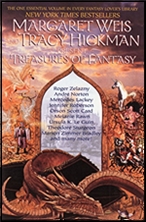
ANNE McCAFFREY “A Proper Santa Claus.†Short story. First published in Demon Kind, edited by Roger Elwood (Avon, paperback, 1973). Collected in Get Off the Unicorn (Del Rey, paperback, 1977). Reprinted in Christmas Stars, edited by David G. Hartwell (Tor, paperback, 1992) and Treasures of Fantasy, edited by Margaret Weis & Tracy Hickman (Harper, softcover, 1997), among others.
Anne McCaffrey is best known for her many books of SF and fantasy in several long-running series, especially her Pern novels. But she was no slow hand at writing short fiction as well, as this small tale demonstrates full well. Please note that in what follows, I will need to tell you more than you may like to know!
It begins when a young boy named Jeremy is about three years old. It seems that he has a special talent. Whenever he draws something or creates something out of clay, and if he does in a proper way, it becomes real. If he draws a cookie on a piece of paper and cuts it out, it is dry but very tasty, but when he paints a glass of Coke, it’s flat, because he forgot to draw in the bubbles.
This remarkable ability stays with him until kindergarten, when at Christmas time he draws Santa Claus bringing him lots of presents. A conflict arises when he can’t do it in a proper way, after his teacher tries to tell him what a proper Christmas is all about, and his special talent is gone forever.
An obvious fantasy, but I’d like to think that it’s also a sort of a “growing up†tale that applies to everyone. Short but extremely well done.